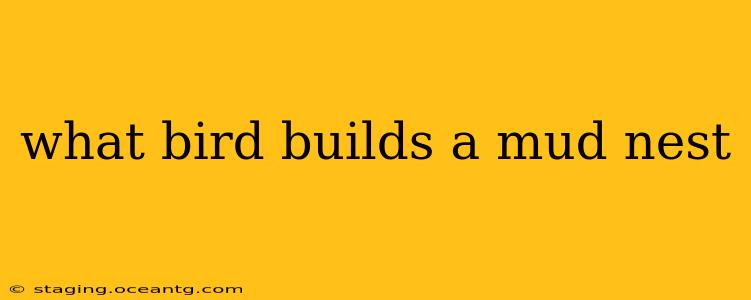Many birds utilize mud as a key component in their nest construction, showcasing incredible ingenuity and adaptation to their environments. While not all mud nests look alike, the common thread is the use of this readily available material to create a sturdy and protective home for their eggs and young. Let's explore some of the fascinating avian architects that specialize in mud-based nesting.
What types of birds build mud nests?
Several bird species incorporate mud into their nest building, employing different techniques and resulting in diverse nest structures. Some prominent examples include:
-
Swallows: Many swallow species are renowned for their mud nests. Barn swallows, for instance, create cup-shaped nests often attached to ledges or beams in barns, cliffs, or bridges. They meticulously collect mud pellets, mixing them with straw and other plant material for strength and stability. These nests are remarkably durable and can last for years, often being reused by the same birds or other species.
-
Cliff Swallows: These swallows build elaborate, flask-shaped nests clustered together on cliff faces or human-made structures. Their mud nests are often adorned with grass and other plant materials, adding insulation and further reinforcing the structure. The communal nesting style is a remarkable adaptation for protection and social interaction.
-
Ovenbirds: True to their name, ovenbirds construct dome-shaped nests that resemble small ovens. These nests are made primarily of mud, mixed with twigs, grasses, and other plant materials, providing excellent insulation and protection from predators. The entrance is typically located on the side, offering a secure entry and exit point.
-
Horned Lark: Horned larks build simpler mud nests, often on the ground, using mud mixed with vegetation. The nests are usually shallow cups, offering a safe haven for their eggs. Their choice of nesting location often depends on the availability of suitable cover and protection from harsh weather conditions.
What is the purpose of using mud in a bird's nest?
Mud plays a crucial role in a bird's nest for several key reasons:
-
Stability and Strength: Mud acts as a binding agent, holding together other nest materials and creating a robust structure that can withstand the weight of eggs and chicks, as well as wind and rain.
-
Protection: A mud nest offers excellent protection from the elements, shielding eggs and chicks from harsh weather conditions such as rain, wind, and sun. The thick walls can also provide some insulation, regulating temperature and humidity.
-
Camouflage: Depending on the environment, the mud's colour can blend seamlessly with its surroundings, providing natural camouflage against predators. The addition of other natural materials like twigs and grasses can further enhance this camouflage effect.
How do birds build mud nests?
The construction of a mud nest is a meticulous process, varying slightly between species but generally involving these steps:
- Mud Collection: Birds collect mud from moist soil, often near water sources.
- Mixing: They mix the mud with other materials like saliva, straw, twigs, and grass to create a workable paste.
- Shaping: They shape the mud mixture into the desired nest structure using their beaks and feet.
- Drying: The mud nest needs time to dry and harden before it can support eggs and chicks.
What are some common materials used with mud in bird nests?
Mud rarely forms the sole component of a bird's nest. Birds typically incorporate other natural materials to enhance the structure's strength, insulation, and camouflage. Common additions include:
- Twigs and Sticks: Provide structural support and framework.
- Grasses and Plant Fibers: Offer insulation and cushioning.
- Hair and Feathers: Add warmth and insulation.
- Saliva: Acts as a natural binder, strengthening the mud mixture.
Do all birds that use mud build the same type of nest?
No, bird nests using mud show significant diversity in size, shape, location, and complexity. The specific design reflects adaptations to the bird's lifestyle, environment, and nesting preferences. Factors like climate, available resources, and predation pressure all influence the type of mud nest built.
This exploration offers a glimpse into the fascinating world of avian architecture. The intricate designs and materials used reflect the incredible adaptability and ingenuity of these feathered architects. Each mud nest is a testament to the remarkable engineering feats of nature.
